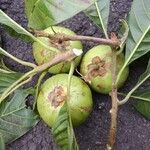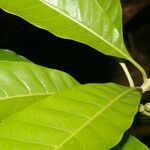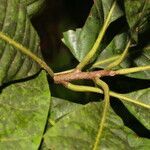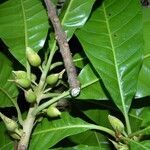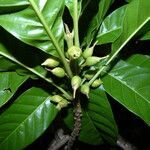Tree to 25 m. Leaves with petioles 6-33 mm long; blades oblanceolate or narrowly obovate to elliptic, often acuminate but sometimes acute or broadly obtuse or virtually rounded, 6.5-30 cm long, 2-8.5 cm broad, glabrous, the sec-ondary laterals subparallel, + perpendicular to the primary laterals (the 3-4 most medial secondary laterals rather strongly arcuate and joining the midvein), the reticulation fine, prominent to subobscure. Flowers 1-9 per leaf-axil; pedicels 5-17 mm long; sepals (4)5-6, ovate (sometimes very broadly so), appressed-puberulent externally, 4-12 mm long, the innermost the longest; corolla cylindric, 7-16 mm long, sparsely to moderately sericeous-strigose externally (glabrous toward the lobe-margins and on the lower portion of the tube), the tube comprising 1/2-2/3 of the total length, the lobes (4)5(-7), oblong; staminodes narrowly linear-lanceolate, often minutely papillose, 2.5-5 mm long; staminal filaments attached slightly below the top of the tube, ca 1.5 mm long, the anthers ca 2 mm long; ovary densely rufous-pubescent, usually 5-locular, the style 5-12 mm long, glabrous except at the base but minutely papillose, the stigma subcapitate, usually 5-lobed. Fruit edible, subglobose or pyriform, apiculate, brown to orange or yellow at maturity, to 7 cm long and broad, the pulp orange or yellow; seeds 1-4, brown, polished, 2-4 cm long, the scar 1-2 cm broad, extending the entire length.
More
A tree up to 8 m high. It can be 30 m high. It is evergreen and has an open crown. The branches are mostly horizontal. The leaves are oval but taper towards both ends. They can be 6-25 cm long by 2.5-8 cm wide. They are shiny and bright green. The leaves are clustered near the ends of the twigs. The leaf stalks can be 5-25 cm long. The small flowers grow in clusters of 2 to 5 on young wood. The flowers have a scent. The fruit is round, slightly pointed at the end, orange yellow and up to 10 cm long. The skin is thin, tough and waxy. The flesh is orange and has a musky smell. The seeds are about 2-3 cm long, dark brown and shiny. There are often 1-3 seeds per fruit.
Trees to 8 m. Leaves: petiole 10-25(-45) mm, finely hairy; blade elliptic to oblanceolate or obovate, 80-250(-330) × 30-80(-150) mm, margins revolute. Pedicels 6-12 mm, densely hairy. Flowers: sepals ovate to suborbiculate, 4.5-11 mm; petals 8-12 mm, tube 5-6(-8) mm; staminodes petaloid, 2-4 mm. Berries 25-70 mm, apex short-rostrate, surface smooth. Seeds 1-6, 20-40 mm.
It is native to C and S America. It is a tropical and subtropical plant. It suits the coast in the tropics and is damaged by frost. It can grow up to 1400 m in the tropics. It will grow on fairly poor soils. It does better on fertile well drained soils. It can tolerate reasonably dry periods. In Brisbane Botanical Gardens. In XTBG Yunnan. It suits hardiness zones 10-11.
More
Moist or wet mixed forest, sometimes in pine forests, often on limestone, at elevations that are mostly below 1,400 metres.
The fruit is eaten fresh or made into icecream. The skin and seeds are removed. It is not good cooked but is used instead of pumpkin in pie. It is used in cakes, pies, custards and puddings. It is used in fruit cups, ice cream and milk shakes. It is often eaten with lemon juice. It can also be eaten with pepper and salt.
Trees are normally grown from seed. Seed need to be planted fresh. Seeds germinate in 2-3 weeks. Seedlings can be planted out after one year. A spacing of 4 m is suitable. It benefits from mulching due to the shallow root system. Plants can also be grafted and grown by air-layering. A spacing of 7-8 m is suitable. Trees should be lightly pruned to give 4-5 well spaced branches.
